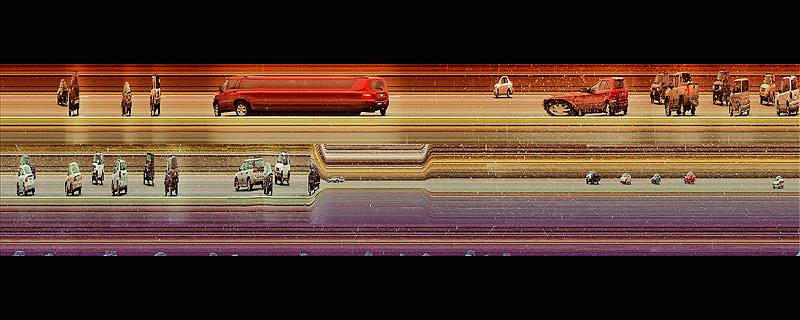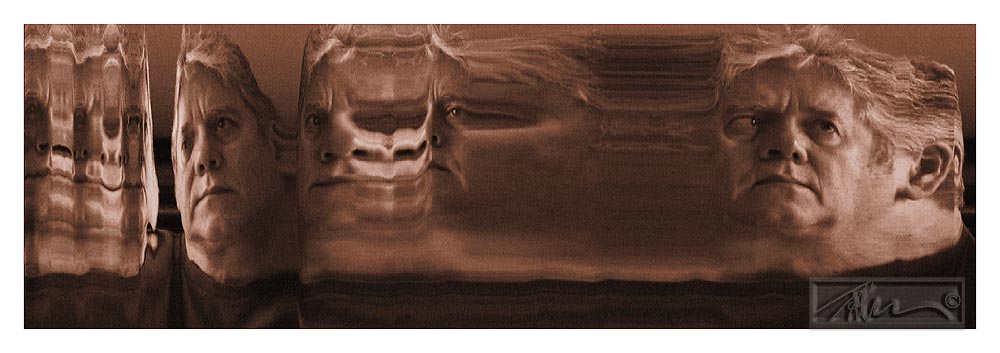The following images are called – Slit Scans. Slit scan is a alternative photographic technique that captures the world in a very unique way. The images produced can be pretty extraordinary.
The slit scans here were created from a video signal. While many cameras these days can produce a panorama simply by moving the camera through an arc, an actual slit scan produces a very different kind of image.
Years ago, many panoramic images were produced using a “Cirkuit” camera. The camera was mounted onto a tripod, it was leveled and the camera spun around its axis. The film, which was moved through the camera in the opposite direction, recorded the scene that passed through a slit, which was in the light-path of the lens.
Cirkuit cameras were also called banquet cameras because they could take a very wide panoramic portrait of a group. In most cases, the subjects were lined up on a circle surrounding the camera. Because the camera moved relatively slow in a single direction, it was possible for someone to be in the picture more than once. Football teams, military groups and weddings were some of the more common subjects for the cirkuit camera.
In the most recent digital cameras, a panoramic image is produced by matching details in multiple images taken at different points in the arc. The images are stitched together by the camera software. With a slit scan, the image is produced from subjects moving through the image slit within the light path of the camera. This can be accomplished with film as well as video. There is also a digital equivalent that produces a similar look.
Most of these images represent a period of motion from the perspective of a single position in space. For the most part, the camera sits in one position as the world passes in front of the lens. In most cases, the only variable is what ever moves during the video capture. The reason we see lines in the background is because that stuff did not move. It is the stationary stuff in the scene that never changes.
I began creating these years ago as a way to record time in a different way. Slit scans created with video; utilize a single or a narrow range of video columns to produce the image. The effect is very similar to a scanner. In fact, a scanner is a slit-imaging device. If you understand how a scanner captures an image, you understand the basic principle of a slit scan. The process records only a single column of the video image. You might think of it as a very thin pie shaped view of the scene. Imagine a vertical triangular section of lens perspective that is only a single or perhaps a few pixels wide.
Depending on the subject and the ways it might move through this view, the subjects seem to stretch and change in scale. Depending upon the direction of the motion, the subjects can be recorded as mirrored. A face for instance will be recorded backwards and forwards if the subject changes its speed or walks backwards. Another example: a car moving in the same direction as the camera has a different orientation than a car that moves in the opposite direction. One portion appears right way around, and the other is recorded as a mirror image.
If the camera stays put, the image will record what moves through the view of the slit. But if the camera moves, the recorded image is made from what the camera passes over. The strange looking stretch and compression happens when subjects stop and go at different speeds through the “slit”. Depending on the direction, subjects become smaller and larger when zooming the lens or as the subject moves closer or further from the camera.
Slit-scans can be great fun to produce and with the right subjects can produce unexpected results. However, it is also possible to predict at least to a degree what might occur. When looking for a possible location to shoot a slit scan, it helps to be aware of the subjects potential for creating an interesting result. After working for a period with this method, it soon become clear as to what might work.
I like to see what happens with a few distortion plugins or perhaps other types of imaging software. It is one of those imaging techniques that can boggle the mind and create some amazing transformations of pretty ordinary subject matter.
There are a number of methods that will produce similar results that can be accomplished with film and digital cameras as well as video and software. I hope to cover some of these in future posts.
Read about my book Rethinking Digital Photography.
Please have a look at some of my other posts here.
NOTICE of Copyright: THIS POSTING AS WELL AS ALL PHOTOGRAPHS, GALLERY IMAGES, AND ILLUSTRATIONS ARE COPYRIGHT © JOHN NEEL AND ARE NOT TO BE USED FOR ANY PURPOSE WITHOUT WRITTEN CONSENT FROM THE WRITER, THE PHOTOGRAPHER AND/OR lensgarden.com. THE IDEAS EXPRESSED ARE THE PROPERTY OF THE PHOTOGRAPHER AND THE AUTHOR.




